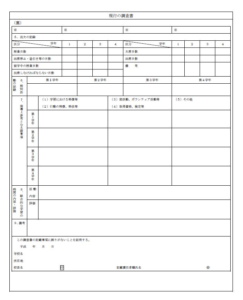The entry fields are expanded for each grade. There are 6 items on the back that can be used as reference for guidance.
By the way, the "matters that can be used as a reference for guidance" on the back of the survey report, which will be expanded by this format change, are classified into the following XNUMX items (XNUMX) to (XNUMX).
(XNUMX) Features in learning, etc.
(XNUMX) Behavioral characteristics, special skills, etc.
(XNUMX) Club activities, volunteer activities, study abroad / overseas experience, etc. (specific content, period, etc.)
(XNUMX) Qualifications, certifications, etc. (contents of qualifications / certifications conducted by principals' associations of specialized high schools, private businesses, etc., acquisition scores / acquisition times, etc.)
(XNUMX) Records of awards and awards (contents and timing of various competitions and competitions, grades and timings of the Science Olympiad, grades and timings of internationally accepted university entrance qualification tests such as the International Baccalaureate)
(XNUMX) Others (activities that students have been involved in)
In the past, it was a form to fill in the above multiple items at once, but after the change, it will be filled in by grade for each item <Fig.>.In addition to this, as in the past, there are also entry fields for "contents and evaluation of comprehensive study time" and "records of special activities (homeroom activities, student organization activities, school events)", so compared to the past. The amount of information will increase dramatically.In addition, if the university requests in the application guidelines to state that it has achieved particularly excellent learning outcomes in a specific field (health and physical education, arts, home, information, etc.) designated by the university in the "Remarks" column. High school needs to deal with this as well.
With such a large amount of information, I am worried about the heavy burden on the high school teachers who create it, and at the same time, I am worried that the university that examines the documents will be able to accept all the information.Although there are differences depending on the university, even in the comprehensive selection and school recommendation type selection, the evaluator reads a lot of aspirations and self-appeal sentences, but in most cases the survey is used as reference material at the time of interview.In some cases, qualifications for acquisition are converted into points and added at the time of pass / fail judgment, but it is generally not used as an examination document.This change in format may be a good opportunity to review the university's document screening method.In addition, the person in charge of the university will need to review at least the manual for the document reviewer and the manual for the interviewer because the format of the survey will change even if the review method is not reviewed.
Will the effect of the portfolio raise the level of self-appeal sentences in comprehensive selection?
Portfolio is one of the tools related to the survey report, but most of the examinees this year have recorded their activity results in the portfolio since they were in high school.This is because the initial policy for admission reform was that the e-portfolio would be used even in general selection.However, in reality, most universities do not utilize e-portfolio for general selection, so high schools and universities have rapidly lost interest in portfolios.However, some high schools continue to provide careful guidance through portfolios as part of their educational activities, regardless of whether they are used for entrance exams.
At these high schools, after school events, students are always asked to look back and summarize themselves.Students who are serious about their portfolio will be aware of what they have learned and what they have acquired through consideration and reflection.It is conceivable that the self-appeal statements, activity performance reports, and reasons for aspirations of the comprehensive selection application documents submitted by such students will be better organized and improved.The fact that the level of documents submitted by many applicants will increase makes it difficult to make a difference in the document screening, which is the primary screening, from the perspective of the university that is reviewing. This is a place for the university to think about whether to increase the number of first-passers more than planned and respond by interviews, etc., or to utilize the survey report with abundant information.
In addition, since there is a blank period in school activities from the end of the second year of high school to the first half of the third year of high school, this year's examinees have certain restrictions on the content that appeals in self-appeal sentences and reasons for aspiration. It looks like it will come.Since not all high schools are SSH or SGH, the content that the applicant appeals to is similar, and there may be many that are targeted at specific school events such as cultural festivals and sports festivals.Universities will need to be prepared to accept this year's unique situation.
- 1
- 2


